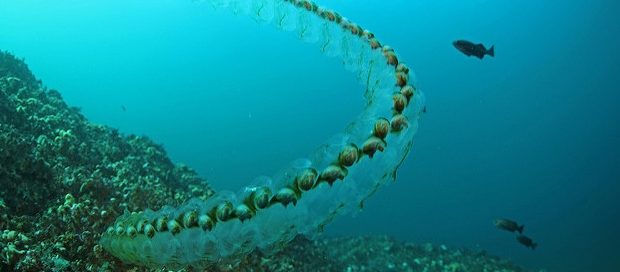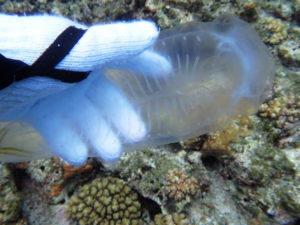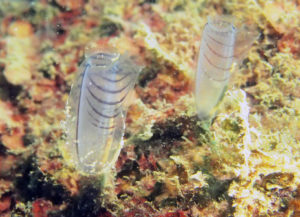
Tunicates are marine invertebrates and include sessile ascidians and planktonic salps. Most tunicates feed on suspended particles in the seawater via filtration. Since many tunicates have a notochord at some time in their life cycle, they belong to the phylum Chordata. Actually, tunicates are regarded as the closest sister group of vertebrates among extant animals on the earth.
Tunicates are the only metazoan group that can produce cellulose. In ascidians and salps, the cellulosic matrix forms an integumentary tissue called a ‘tunic’ that is on the outside the epidermis.

Most salps and some ascidian species have a transparent tunic, and as such these animals are barely visible underwater. This may be an adaptation for the avoidance of visual predators, such as fish. Although the transparent tunic is appropriately almost transparent in visible and ultraviolet light, careful divers can occasionally recognize transparent tunicates by light reflection from the tunic surface.
Light reflection occurs at the border between two media having different refractive indices, and the reflectance is determined by the incident angle of light and difference of the refractive indices between the media. Using an Abbe refractometer and ellipsometer, we measured the refractive index of the tunic from the salp Thetys vagina and the ascidian Rhopalaea sp. The refractive index of the tunic for both species was estimated to be just slightly (0.03 or less) larger than seawater. The difference between the tunics and seawater is so small that reflectance on the tunic surface should be very small.
Additionally, an array of nipple shaped protuberances (nipple array) has been found on the surface of various animals, including tunicates. Each protuberance is only about 100 nm in height. The nipple array was first discovered on moth eyes, and this structure is well known to reduce reflectance; the so-called ‘moth eye effect’.

Nipple arrays were also found on the tunics of some salps that are distributed near the sea surface in the daytime, implying a function for invisibility under bright circumstances. According to our simulation of light reflection, reflectance on the nipple array is slight lower than that of a flat surface, but the height and distance between the nipples are not optimized for anti-reflection. Moreover, the difference of refractive indices between the tunic and seawater may be too small to allow the nipple array to have a functional effect.
As nipple arrays are known to be multifunctional structures, the tunicates’ nipple array possibly serves other function(s), such as bubble repellency or anti-immune responses. To investigate these possible functions, we may need the help of fluid mechanic researchers.
- Tunicates: hiding in plain sight - 30th May 2017
Comments